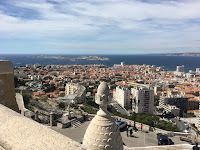Judy.
From the time I first
went to Europe, back in the ‘70’s, I’ve been told to avoid Marseille: port city, Corsican Mafia, drugs,
prostitutes, kidnappings. Actually, that reputation is centuries old. In the
sixteenth century, the Chamber of Commerce demanded a section of the city be
demolished because of the gambling and prostitution. I guess it’s a reputation
well deserved.
But in 2013, it
was a European Culture Capital, like Pecs, Hungary, and Plovdiv, Bulgaria, so
the city was scrubbed clean, and since then, tourism has gone from 1.5 million
people per year to 5+ million. I guess it worked. Friends of ours who also love
to travel told us that they really liked the city, and even Rick Steves gave it
a hearty thumbs up, so we decided to give it a go, and are so very glad we did.
 |
| At the "Old Port" |
From Aix,
Marseille is about a 40-minute bus ride (at 1.5 euros each, thanks to being old
folks), and the old port is about a 15-minute walk from the bus/train station.
At the port, we met up with a Free Walking Tour in English. (We LOVE these
things!) There were about twenty-five in
our group, from all over the world, but all spoke English. Our guide, Ezekiel,
is originally from Argentina, but has lived in Marseille long enough to know a
lot about it.
Ezekiel says the
story of Marseille is of construction and deconstruction, so not a lot of the
oldest part is left, just enough for you to get a sense of it. Actually, it
claims to be the oldest city in France, settled by the Greeks for use as a
port. He walked us to the ruins of the ancient Greek port, located on the
grounds of the Marseille Museum of History, about a quarter mile from the
present port. It’s now a lush park, part of the museum, and surrounded by a
hideous shopping center that was being built when it was discovered. Reasonable
compromise, I suppose.
 |
| Greek Port |
From its gate, we
walked down the oldest street in France to see an eclectic series of
buildings. There’s a street designed by
Haussmann, a city commissioner who designed much of Paris. It was built to draw
the elite back to the city center, since Marseille for centuries has housed the
working and poor downtown and the rich in the suburbs. It didn’t work, but it’s
a pretty street.
There
is an old neighborhood that was destroyed by the Nazis because the French
Resistance hid out in the brothels and bars. Less than ten buildings were left,
and those because of their historical significance. One, several stories high,
was actually sawed off at the bottom, moved, and turned 90 degrees to
accommodate the street being widened. A
huge convent-hospital (now an ultra-expensive hotel) and the customs house were
among the others saved.
 |
| Le Panier |
 |
We
walked through Le Panier, one of the old dangerous neighborhoods, which was
preserved and renovated to house the “Bobos”—Bourgeois Bohemians (typically
young people that like to live well in slummy areas). There is still graffiti,
along with murals and sleek touristy shops. We passed a former convent that
housed reformed prostitutes: Convent du
Refuge, once located on Rue des Dèshonneurs
(Dishonor Street), which the Bobos petitioned to have changed to Rue des Honneurs. I guess they didn’t want to live on Dishonor
Street…


Near
the expanded harbor, is a massive Cathedral, which Ezekiel told us was
built because the original 1000-year-old church looked too small for such a
large harbor. (Deconstruction and construction, remember?)
 |
| Fishermen's church |
Past
the Cathedral is the magnificent new art museum, connected to Fort
Saint-Jean in one of the oldest parts of the city via a sleek bridge. We ended
the tour there, across from an old church, which was a parish for the
fishermen.
 |
| Bridge from museum to Fort |
A
note here: everyone on the tour spoke English, no matter where they were from.
There were two young women from the US, the only US citizens besides us. They
were loud, disruptive, and constantly dropping the f-bomb. Believe me, every
one of the quiet, respectful tourists knew where they were from and what they
were saying. It was humiliating. If you happen to be a loud, cursing North
American (and I’ve been it), please realize what you look and sound like in
other countries. As it is, folks are wondering about us.
We
wanted to try the bouillabaisse, but were warned from numerous sources that the
only decent bouillabaisse was fifty euros per serving, so we opted for an outdoor
café in Le Panier with a view of Notre Dame de la Garde, a basilica high above
the city. Mussels and fish were a reasonable substitute.
After
lunch we caught the number 60 bus up the hill to Notre Dame, which is perched
atop an old fort at the top of the hill. Built in the nineteenth century by
Napoleon III, it is a wonder of gold and mosaics, with a commanding view of the
city and the ocean, including Île d’If, for Count
of Monte Cristo fans.
 |
| View of Marseille |
 |
| Notre Dame de la Garde |
By
this time, we were bushed and decided to head back home. There’s so much we
DIDN’T see—the Picasso exhibit, a boat ride to the islands, the history
museum—the list goes on. As always, we save something for next time. But you?
You should go.




No comments:
Post a Comment